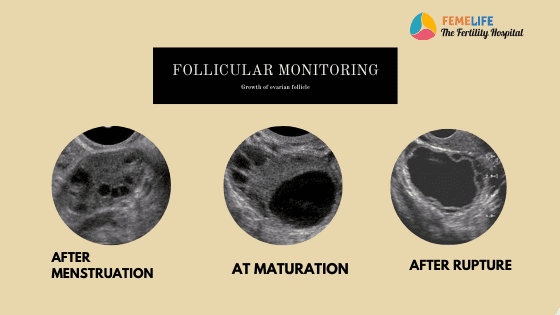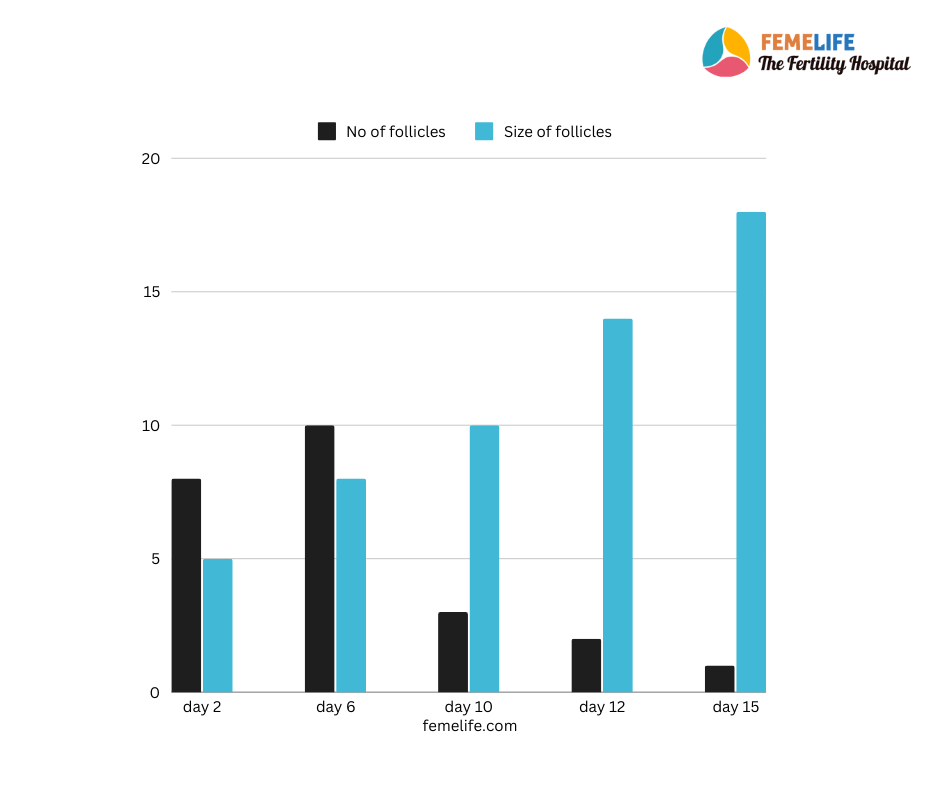What is follicular monitoring?
Follicular monitoring is the process of tracking growth of the ovarian follicles to identify maturation status of eggs. This is done by serial ultrasound imaging. Ovarian follicles are the basic units of female fertility. Each of the follicles contains a single egg. These structures are periodically initiated to grow and develop, leading to release of a single mature egg in female. Apart from nurturing the egg, follicles also contain cells which produce hormones in you. Follicular monitoring tells us about the time of follicular growth and release of egg. This helps in administering medications in time. Follicular monitoring is an important part of IUI and IVF program.
What are ovarian follicles?
Ovarian follicles are the basic units of female reproductive biology. Each of them contains a single oocyte (egg). We can visualise the follicles through ultrasound imaging. But eggs are very minute structures not visible in naked eye. That is to say, we can monitor the growth of follicles but not eggs. These follicles support the human eggs by feeding them and also consequently release them after maturation.
What is the best size of follicles to ovulate?
Follicles are minute in size around menstrual days. Slowly they grow and mature. A mature follicle of size more than 16mm is ready to ovulate (release egg). Every follicle in the ovary has the potential to mature and ovulate. However, this seldom happens. Growth of follicles is a complex process, in other words it is a balance between recruitment and senescence of follicles. As a result, some of the follicles grow upto maturity, whereas others decline in the midway.
What is follicular study test?
Follicular study is charting the follicular growth after the menstruation. Follicular monitoring is completed at ovulation. Usually follicles start growing 3 to 5 days after menstruation. Slowly they grow with rise of hormones to attain a size of 16mm to 20mm. At this stage the egg is mature enough for fertilisation. After release of egg, that is after ovulation the follicle start releasing progesterone hormone. Thus it turns into a supporting organ for pregnancy.

At what size does the follicle rupture?
Follicles mature and rupture at 18 to 20 mm size. Ovulation happen around 12th to 18th day of Cycle. Follicles are minute in size at the beginning of menstrual cycle. Gradually the follicles increase in size under hormone effect. As a result the follicles grow to the size of 20 mm. At this size chemical stimulation helps rupture and release of egg. Consequently the egg is picked up by the fallopian tube for fertilisation.

What is done in follicular Study?
Assessment of the follicular maturity and endometrial receptivity is done by ultrasound follicular testing. We can serially measure the follicle size and endometrium thickness by ultrasound in a menstrual cycle.
Follicular study
| Day of cycle | Follicular size | Endometrium thickness & structure |
| Day 2 | 3-5mm | Thin or shedding endometrium |
| Day 7 | 5-8mm | 5-7mm, triple line |
| Day 10 | 10-12mm | 6-8mm, triple line |
| Day 14 | 16- 18mm | 8-12mm, triple line changing to secretory |
| Day 18 | collapsed follicle | 8-12mm, secretory |
How does follicular measurements using a computerized 3D ultrasound system help?
In 3D ultrasound, follicular volume can be measured. It also gives idea about blood flow to the tissue. Ovarian function may be measured by gynaecologic ultrasonography of follicular volume.
Which type of ultrasound is better for follicular study?
Transvaginal ultrasound has advantages of better clarity about the uterus and ovaries over transabdominal USG.
How to prepare for a follicular tracking ultrasound?
For follicular tracking through transvaginal ultrasound patient is asked to empty urine just before the test. She does not need to come in empty stomach.
What to expect from a follicular tracking ultrasound?
Follicular monitoring tells us about the time of follicular growth and release of egg. This helps in administering medications in time.
How long does a follicular tracking ultrasound examination last?
Usually a transvaginal ultrasound is completed within 15-20 minutes.
Follicle monitoring for PCOS – how it is different?
In PCOS there are more number of follicles and high chance of ovarian hyperstimulation.
Why hormone tests required during follicular monitoring?
Sometimes hormone tests are combined with follicular monitoring to have a better idea about quality of egg.
When should follicular study start?
Ideally follicular study should start from day day 3 of the cycle, to assess a baseline size, as well as exclude if any cyst remains from previous cycle.
What is the role of AMH in follicular monitoring?
Serum AMH measurements are a better predictor of the number of early antral follicles than conventional hormone measurements. Patients with AMH of 3- 5 are expected to grow follicles well.
What is a follicular cyst?
Sometimes the maturing follicle ( dominant follicle ) grows at a good pace but fails to ovulate, and later becomes a cyst filled with fluid only.
Why some follicles do not rupture?
At times follicles form cysts and don’t rupture. This happens frequently in elderly patients or patients with low ovarian capacity. It may be due to poor quality of oocyte.
Facts of follicular growth in Ovary
- Follicles in the ovary of a girl child are not growing and are in the sleeping stage.
- Follicles in the ovary grow progressively in the early half of menstrual cycle.
- Each mature follicle contains an egg surrounded by cells called cumulus.
- A mature egg only can be fertilised by a sperm.
- Healthy sperms with good movement are essential to fertilise an egg.
- In ultrasonic monitoring we can only see the follicle filled with fluid.
- Human eggs are not visible to naked eye and can only be seen under microscope.

